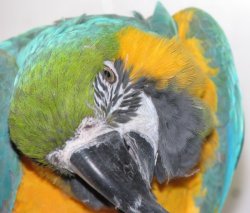I know she was used as a breeder at an aviary not far from where I live and because her band has the initials of this breeder, I know she was hatched there. I don’t know if she was kept back as a breeder or if she was sold and then returned later as a breeder. I don’t know how many chicks she had (if any) or where any of them are now.

I know that due to the death of one of the partners in this aviary, all the birds were sold a few years ago and that Kia went to a man, who, unfortunately appeared to know very little about birds. I recall receiving a few phone calls from this man wanting to sell her, due to noise – but no one in the parrot club that I belong to was interested.
I know that this man finally walked into a local pet store and gave Kia to them a few months before she came to live with me. He told them that she had an illness and that he couldn’t take it any more.
I know that the pet store took Kia to an avian veterinarian who diagnosed the illness as cloacal papilloma and gave them advice on the treatment.
I know that the pet store then phoned a friend of mine to tell her that she could have Kia for no charge. They also told her that her illness did not affect her and that it was not contagious to her other birds.
I know that my friend was unable to take Kia at this time so she asked her brother (who already had a macaw) to keep her. He kept her for a few months before deciding that his other macaw was jealous of Kia and he sent her to my friend’s place. She was also taken to one of our parrot club’s displays while in his care since he was under the impression that her illness was not contagious.
I know that my friend had Kia for about 2 months before she decided that she could not keep her because she had a baby granddaughter staying with her, who was terrified of her.
At this point Kia came home to live with me. I had not heard the name of her illness but just knew that something was wrong with her and that it was not contagious.
I was told that a veterinarian had seen her, so one of the first things I did was to contact that office to see if I could get the information from the visit. Unfortunately, I had been given the wrong veterinarian information, so I decided to contact the pet store to ask them who had seen Kia.
The pet store provided the correct information, so I then contacted the veterinarian who had seen Kia. When I spoke to her, I finally had a name for the illness “cloacal papilloma” and was disappointed to find out that this was a contagious disease, especially to South American birds – but other birds have also been known to have this disease. Direct contact or mutual preening is thought to be the manner of contracting this disease.
Luckily, I do not have South American birds and Kia had not been in contact with any of them anyway.
I took Kia in for a more thorough examination and other than her cloacal papilloma, she is in good health. I have made changes in her diet to help control the swelling and this seems to be working.
I gave Kia her new name when she came to live with me. She was named Kiwi until then – or at least from when the man purchased her from the aviary. She did not appear have a problem with the name change and is a very sweet bird.
A new toy will sometimes hang in her cage for several weeks before she decides one day to completely destroy it.
She is a macaw, so she has a macaw yell (scream). This normally only occurs in the morning and the evening as well as any time I am on the phone.
Kia often says the name “Dudley”. I don’t know if this was her mate – or if it might have been a dog in a former home – or if it was a person she had known.
Cloacal papilloma – papillomas are wart like growths that can appear anywhere from the mouth to the cloacal (vent) area of parrots. They can increase and/or decrease in size from time to time and can bleed and cause discomfort to the bird.
It is contagious, but it is thought that touch or mutual preening is necessary to spread it.
One thing that seems to control it is eating dried chili peppers as well as a main diet of Harrison’s Pepper Pellets.
Surgery can be used to remove the papilloma, but in most cases, it appears that the papilloma will return.
For more information on Cloacal Papilloma – please see
Cloacal Papillomas in Psittacine Birds: A Retrospective Histopathologic Review
Investigations into the Etiologic Agent of Internal Papillomatosis of Parrots and Ultrasonographic and Serum Chemical Changes in Amazon Parrots with Bile Duct Carcinomas
Update
Unfortunately, due to a personal illness, I was forced to rehome Kia in 2006. She lives near enough for me to visit on occasion.
For more information on Macaws, here is a book from Amazon.com that you may like:


